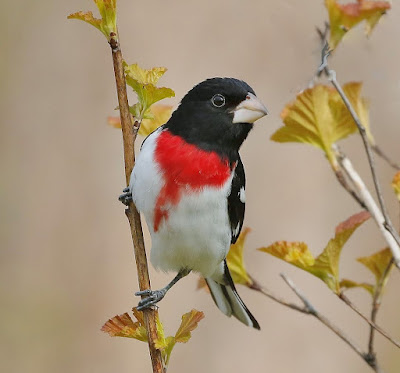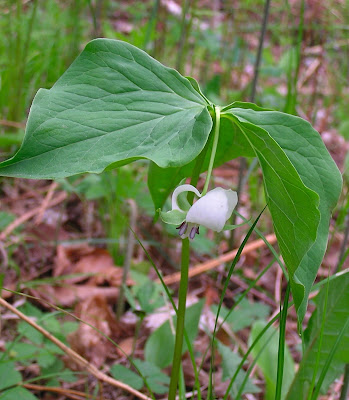A Northwoods Almanac for May 26 – June 8, 2023
Ice-Off – It Took Awhile!
Ice-off for the larger lakes in our area occurred well into the first week of May. Thankfully the fishing opener wasn’t until May 6, and I believe all our lakes were open by then. Judith Bloom emailed me that ice-out on Tomahawk Lake occurred on May 5th, the “same date as last year,” she said.
On smaller lakes, the ice went off a few days earlier. Woody Hagge has been keeping ice-off and ice-on dates for 39-acre Foster Lake for 51 years, and noted that the ice went off Foster Lake on April 29. This was a tie for the fifth latest ice-off date in his records.
However, he was also added that since 2000, the ice went off the earliest in 2012, 2nd earliest in 2000, 3rd earliest in 2010, and tied for 4th earliest in 2007. So, while in the last two decades, we’d had some late springs, we’ve also had quite a number of early ones.
His summation of what’s going on: “Clearly, climate change is causing wild swings in temperatures.”
Sightings and FOY (First of Year)
5/7: We heard our FOY black-throated green warbler and Blackburnian warbler in the Van Vliet Hemlocks.
5/8: Judith Bloom on Lake Tomahawk saw her FOY rose-breasted grosbeak, the same day we saw our first one in Manitowish. That morning we also saw our FOY brown thrasher and yellow warbler, and back in the Frog Lake and Pines SNA, we found our first trailing arbutus in flower. That evening we heard our FOY leopard frogs.
 |
| rose-breasted grosbeak photo by Bev Engstrom |
5/9: Judith Bloom saw her FOY ruby-throated hummingbird, as did we in Manitowish. Judith also saw her FOY common loons. She noted, “The male loon in this territory has held it from 2008 and is a great Dad.”
I forgot to note in my last column that Pat Schmidt on Silver Lake in Hazelhurst won the award for first loon pair sighting, at least that I heard about on a lake – 4/27.
Also on 5/9, we spotted our first of many hepaticas in the Frog Lake area, and in doing our first frog count of the year for the DNR, we heard our FOY American toads and several whip-poor-wills.
5/10: Jo Knapp in Presque Isle saw her FOY rose-breasted grosbeak, as well as her first ever red-headed woodpecker, a bird which remains quite uncommon up here. Mary and I saw our FOY white-crowned sparrows below our feeders, saw wild strawberries in flower, and could see the adult eagle feeding a chick in the nest across the river from us.
5/12: Judith Bloom had her FOY indigo bunting, and we had our FOY wood anemones.
 |
| Indigo bunting photo by Bev Engstrom |
5/15: Callie and I came across dozens and dozens of goldthread wildflowers, and Mary and I heard our FOY northern waterthrush on the Bear River. We also had our one and only large-flower trillium on our property come into bloom, as did several patches of nodding trilliums.
 |
| nodding trillium photo by John Bates |
5/16: Jennifer Heitz sent a photo of a common green darner dragonfly that she rescued from the water before a fish or bird could get it. She noted that, “it was at least 3” long with a beautiful green and blue body.” Green darners migrate by the thousands in the fall and lay their eggs where they overwinter in the southern states. Their offspring then return in the spring and are often the first dragonflies we see in the Northwoods.
 |
| common green darner photo by Jennifer Heitz |
5/18: We encountered our first hatch of mosquitoes. We had two weeks of blessed hiking in snowless and bugless woods, but we were keenly aware that this would soon end, and so it has.
Wildflowers!
Snow still laid in patches in most woodlands as May began, but once the weather warmed and the snow disappeared, our ephemeral wildflowers burst quickly into bloom. And not just wildflowers – many shrubs and trees, too. In our yard, many years ago we planted a pear, a plum, and several Juneberry trees, all of which came into flower on 5/15, and are already going by as of 5/19. But what a dazzle it’s been for these four days, and with our lilacs, crabapples, black and choke cherries, mountain ashes, and apple trees soon to flower, the sheer beauty of late May can easily take your breath away.
Trees are also quickly leafing out, so the spring ephemeral wildflowers have their work cut out for them. They have to flower, be pollinated, and start going to fruit/seed while the sun still peeks through the tree branches. Once full leaf-out occurs in the hardwoods, the sunlight on the forest floor may only be an occasional dappling, cutting off the wildflowers’ source of photosynthesis.
So, it’s a race. If you want to see any of it, your time is short at best.
Goldthread (Coptis trifolia)
 |
| goldthread photo by John Bates |
These delicate May flowers thrive in cool, moist woods, particularly cedar swamps, and in bogs, but also grow under conifers, and often right in moss. Each flower grows singly on a long thin stem with 5 to 7 white petal-like sepals arranged in a star. Its evergreen leaves are divided into three fan-shaped, scalloped leaflets that look a bit like barren strawberry. If you are still in doubt about its identification, carefully expose the slender, brilliant yellow roots from which the name was derived.
The roots branch into underground horizontal rhizomes that vegetatively reproduce by sending up shoots, often creating carpets of goldthread in deep woods.
Goldthread was once called “canker-root” because of its use as a remedy for sore and ulcerated mouths. Most herbs were historically used in a host of different ways, but goldthread had unusual consistent use among various tribes – Mohegans and Montagnais boiled the root and used the solution for a gargle; Penobscots chewed the stems to prevent sores in the mouth; similar use was made of the root by Menominees, Potawatomis, and Pillager Ojibwas. Historical references say the root was also commonly used for lessening the pain of teething. The root contains the alkaloid berberine which exerts a mild sedative action, explaining its popularity as a pain killer. Widely used as folk remedy, goldthread roots dried for market in 1908 fetched sixty to seventy cents a pound.
Scrape soil away from the roots to expose the wiry rhizomes “made of gold,” then carefully replace the soil and pat it down.
Lake Clarity Means Higher Property Values
(From Ted Rulseh’s highly recommended book Ripple Effects by University of Wisconsin Press):
“For most lake residents, a direct self-interest lies in the value of their property. Study after study ties the quality of lake environments to property value, and to the vibrancy of community economies and the fiscal health of local governments. That is especially true in lake-rich tourist areas like northern Wisconsin, Minnesota, and Michigan. To cite just a sampling of evidence: A Bemidji State University study of 1,205 property sales on thirty-seven lakes in six regions of northern Minnesota found that water clarity was the most important factor in determining lakeshore property values. Professor Patrick Welle, one of the investigators, noted that on average, properties on all lakes in those six regions would rise in value by fifty dollars per foot of lake frontage if water clarity increased by one meter (a little more than three feet). ‘Now Realtors can talk of location, location, location and clarity, clarity, clarity,’ noted Welle.
“A University of Wisconsin–Whitewater study, looking at 3,186 real estate sales over ten years on seven lakes in northwest Wisconsin, found that properties on lakes with good water quality had values two to three times higher than on lakes with poor-quality water.
“A Michigan State University study examined the body of evidence on the connection between water quality and property prices. Reviewing forty-three studies, the researchers found that all but two showed a statistically significant relationship: ‘As a whole, they provide convincing evidence that clean water has a positive effect on property value.’
“A study by the University of Wisconsin–Madison found that properties on lakes infested with Eurasian water milfoil experienced an average 7.7 percent decrease in total value.
“A University of Wisconsin–Eau Claire study estimated gains in property value related to water clarity on sixty lakes in the state’s Vilas and Oneida counties. It concluded that a one-meter increase in clarity would boost the market price of an average lake home by $8,090 to $32,171 . . .
“Another study in Wisconsin’s Oneida County projected the impact on the economy and local government revenue if lake quality were to decline significantly. In that event, according to surveys cited, seasonal residents would spend less time at their properties, and up to 50 percent of visitors would find other vacation destinations. This would cost the county’s economy more than $100 million per year; the county would risk losing $2 billion in property value and $19 million per year in property tax revenue.”
Not all lakes were created with equal water clarity – some are naturally stained. Whatever their natural coloration, however, these studies are crystal clear in linking the healthiest lakes with the healthiest monetary valuation. Famous oceanographer Sylvia Earle said in relation to the profound importance of water to all life, “No blue, no green.” We can also say something similar in relation to the importance of water clarity to economic value, “No blue, less green.”
Celestial Events
June is on the horizon, and planet watching is fine this month. Look after dusk for both Venus and Mars in the southwest, with -4.5 magnitude Venus easily outshining 1.6 magnitude Mars. Remember that the scale is logarithmic – each step down of one magnitude is 2.512 times brighter than the magnitude 1 higher. Thus, a magnitude 1 star is exactly 100 times brighter than a magnitude 6 star. Venus, at almost six full magnitudes brighter than Mars, is over 200 times brighter.
If you’re awake in the dark before dawn, look for Jupiter (-2.1 magnitude) in the east and Saturn (0.9 magnitude) in the southeast.
June’s full moon occurs on the 3rd. Called by many lovely names – the “Strawberry” or “Rose” or “Honey” moon – I’m particularly prone to seeing it as the “Strawberry” moon given that our first wild strawberries are usually ripe by mid-month with our first farm-grown strawberries not far behind. As Izaac Walton said, “Doubtless God could have made a better berry, but doubtless God never did.”
Quote for the Week
“Knowing what I do, there would be no future peace for me if I kept silent,” Rachel Carson wrote in a letter to her closest friend Dorothy Freeman, ninety days before the release of her 1962 book Silent Spring.
Please share your outdoor sightings and thoughts: e-mail me at manitowish@centurytel.net, call 715-476-2828, snail-mail at 4245N State Highway 47, Mercer, WI, or see my blog at www.manitowishriver.blogspot.com.

